The Dynamics of China’s Collaborative Innovation Network in Agricultural Biotechnology: A Spatial-Topological Perspective
Abstract
:1. Introduction
2. Methods
2.1. Data Collection
2.2. Identification of the Phases in Life Cycle
2.3. Data Processing and Network Construction
2.4. Topological-Network Analysis
2.4.1. Analysis of the Nodes
2.4.2. Analysis of the Edges
2.4.3. Analysis of Overall Network
3. Results
3.1. Identification of the Phases in Life Cycle
3.2. Dynamics of the Spatial Network
3.2.1. Dynamics of the Cities
3.2.2. Dynamics of the Collaborations among Cities
3.2.3. Dynamics of the Overall Spatial Network
- (1)
- Over time, the distribution of collaborations, no matter whether local or crossing the city, displays an east–middle–west diffusion trend, and the overall strength of collaborations increases synchronously.
- (2)
- Regional innovation cluster with star cities as the cores are taking shape. With Beijing as the core, the Beijing–Tianjin innovation cluster is being formed; Suzhou, Hangzhou, Nanjing, and Yangzhou are forming the Yangtze-River-Delta innovation cluster around Shanghai; the Pearl-River-Delta innovation cluster containing Dongguan and Zhongshan is forming, with Guangzhou and Shenzhen as the cores. Meanwhile, the collaborations both in and among the clusters are strengthened simultaneously.
- (3)
- There is a clear regional imbalance in agricultural-biotechnology innovation, and the imbalance is increasing. On the whole, innovation-related resources are obviously inclined towards eastern China, and this region has obvious advantages in terms of the quantity and strength of collaborations. Furthermore, star cities such as Beijing, Shanghai, and Guangzhou, as well as Shenzhen and the corresponding surrounding regions, Beijing-Tianjin, the Yangtze River Delta and the Pearl River Delta have obvious advantages in innovation collaborations.
3.3. Dynamics of the Topological Network
3.3.1. Dynamics of the Innovators
3.3.2. Dynamics of the Collaborations among Innovators
3.3.3. Dynamics of the Overall Topological Network
- (1)
- The core-edge structure of the network is prominent. This is highlighted by the fact that the network as a whole is increasingly divided into core and edge areas. As with the nodes located in the core area, the number of nodes connected to them and related collaborations established are significantly more than those in the edge, indicating that the collaborative connections between innovators in the core area are complex, and the attribute of the small-world is particularly obvious. However, the collaborative connections between innovators in the edge have relatively important limitations; they are often limited to the same or a few innovators for carrying out collaborations.
- (2)
- The positions of universities, research institutes and enterprises are changing obviously. Whether it is binarized (Figure A3a) or weighted (Figure A3b), in the maps of the introduction phase universities occupy core positions, especially for the binarized network, and famous universities such as Tsinghua University and Fudan University are always dazzling stars. In the maps of the growth phase, universities in the binarized network are still irreplaceable, but in the weighted network Beijing Dabeinong Group Co., Ltd., BGI Co., Ltd. and COFCO Group Co., Ltd., as well as their subsidiaries, are beginning to appear in the core area and occupy dominant positions. This dynamic is more obvious in the maps of the maturity phase. Although in the binarized network of 2016–2017 universities still firmly occupy the core position, in the weighted network Beijing Dabeinong Group Co., Ltd., COFCO Group Co., Ltd., and Aonong Group Co., Ltd., as well as other enterprises, have become the main forces in agricultural-biotechnology innovation.
- (3)
- It is the combination of geographical, cognitive and organizational proximity that drives the dynamics of innovation networks, but the main driving factor is evolving from geographical proximity to organizational proximity. Figure A3b illustrates that, from 1985 to 2007, the strong collaborative connections are mainly enterprise-university collaborations based on geographical proximity, while in the maturity phase of 2016–2017, collaborations are more strongly established between enterprises based on organizational proximity, especially between parent subsidiaries or sister companies.
4. Discussion and Conclusions
Funding
Data Availability Statement
Acknowledgments
Conflicts of Interest
Appendix A
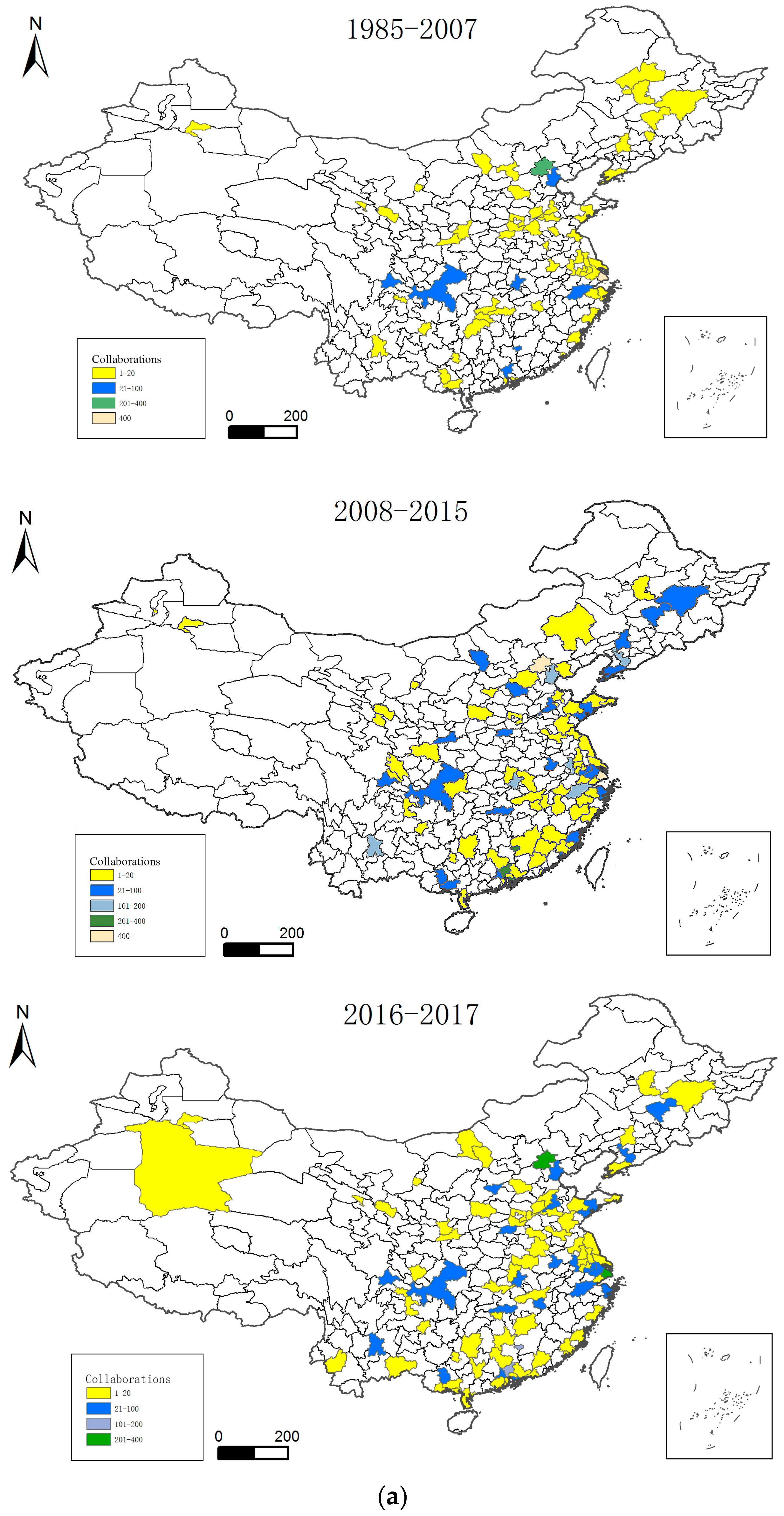
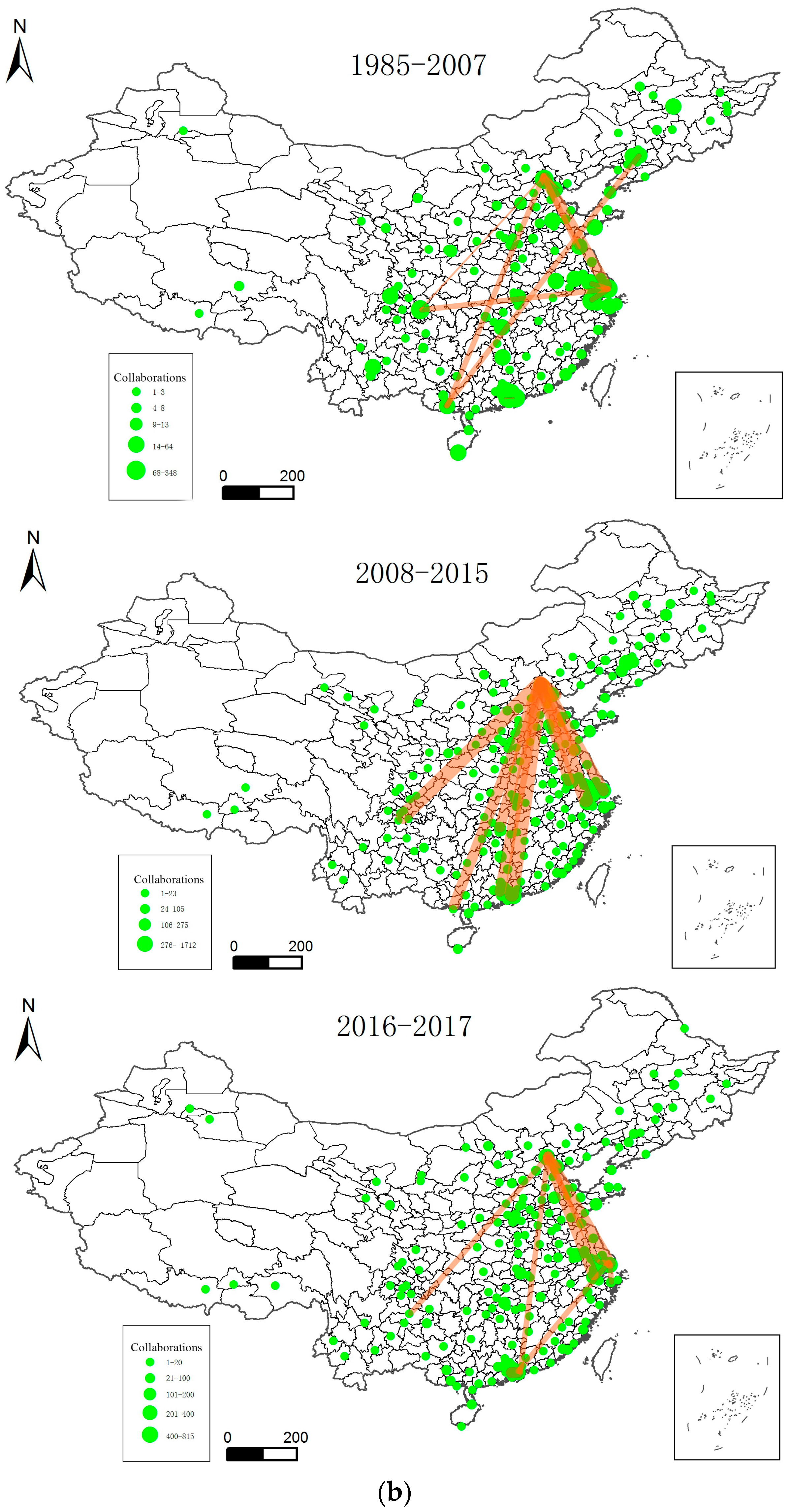


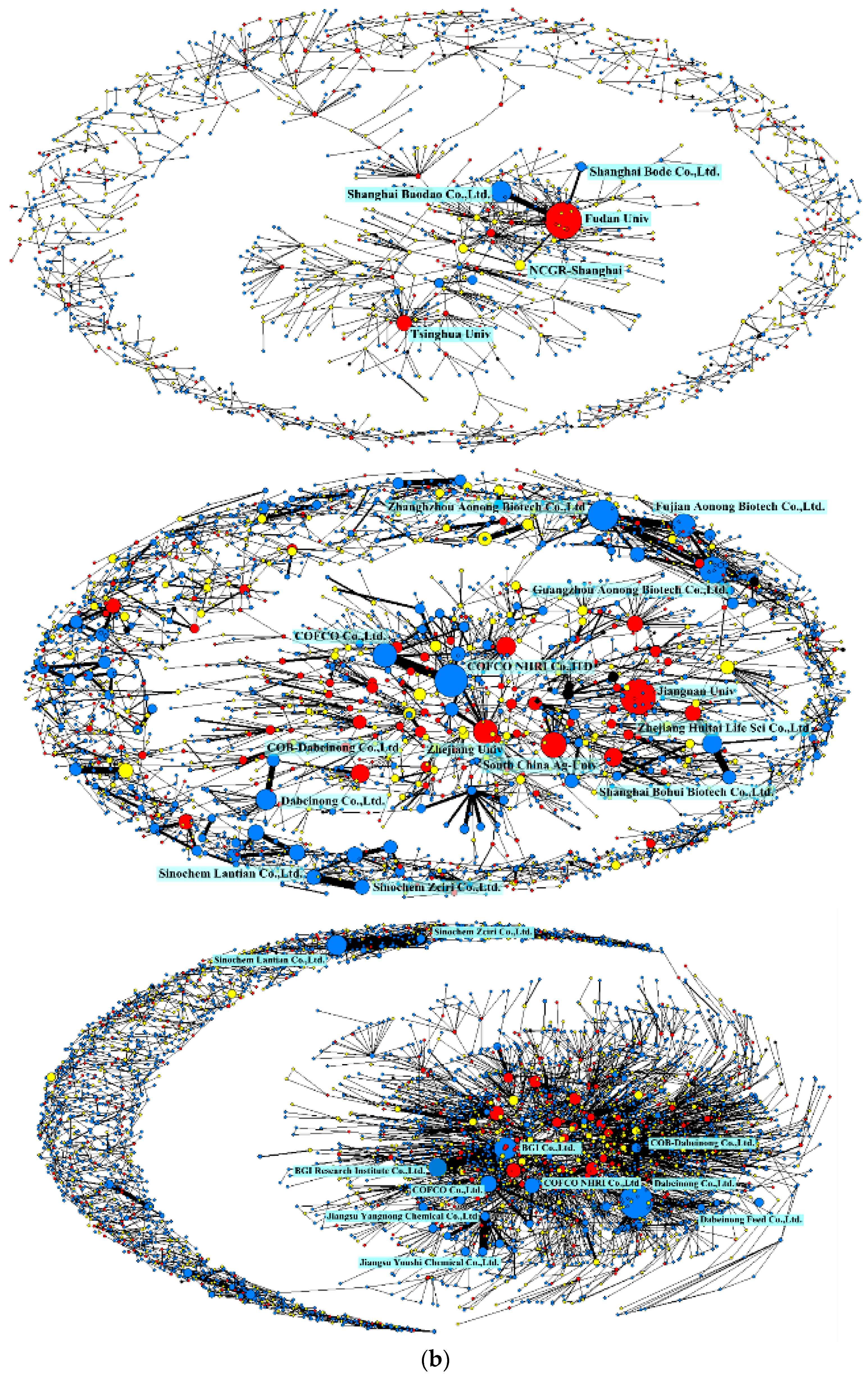
| 1985–2007 | 2008–2015 | 2016–2017 | |||
|---|---|---|---|---|---|
| Innovator/DC/Ab-DC (Binarized) | Innovator/DC/Ab-DC (Weighted) | Innovator/DC/Ab-DC (Binarized) | Innovator/DC/Ab-DC (Weighted) | Innovator/DC/Ab-DC (Binarized) | Innovator/DC/Ab-DC (Weighted) |
| Tsinghua Univ /33/0.025 | Fudan Univ /357/0.001 | Zhejiang Univ /85/0.02 | Beijing Dabeinong Group Co., Ltd./367/0 | Jiangnan Univ /43/0.014 | Jiangnan Univ /89/0.001 |
| East China Univ of S&T/29/0.022 | Shanghai Bodao Gene Tech Co., Ltd./195/0.001 | Jiangnan Univ /70/0.017 | BGI Co., Ltd. /229/0 | Nanjing Agriculture Univ/31/0.01 | COFCO NHRI Co., Ltd./81/0.001 |
| Fudan Univ /28/0.021 | Tsinghua Univ /100/0 | East China Univ of S&T/54/0.013 | BGI Research Institute Co., Ltd./181/0 | South China Agricultural Univ/29/0.01 | Zhangzhou Aonong Biotech Co., Ltd./77/0.001 |
| Zhejiang Univ /25/0.019 | NCGR-Shanghai, CAS /80/0 | Shanghai Jiao tong Univ/49/0.012 | COFCO Co., Ltd. /164/0 | Zhejiang Univ /25/0.008 | Guangzhou Aonong Biotech Co., Ltd./66/0.001 |
| SIBS, CAS /24/0.018 | Shanghai Bode Gene Tech Co., Ltd./62/0 | South China Agricultural Univ/47/0.011 | COFCO NHRI Co., Ltd. /149/0 | Sun Yat-sen Univ/22/0.007 | South China Agricultural Univ/64/0.001 |
| Nankai Univ /14/0.011 | East China Univ of S&T /52/0 | Tsinghua Univ /41/0.01 | Zhejiang Univ /139/0 | East China Univ of S&T/20/0.007 | COFCO Co., Ltd. /61/0.001 |
| Shandong Univ /14/0.011 | SIBS, CAS /41/0 | Nanjing Agriculture Univ/40/0.01 | Jiangnan Univ /131/0 | Huazhong Agricultural Univ/20/0.007 | Zhejiang Univ /59/0.001 |
| Sun Yat-sen Univ /14/0.01 | Sino Geno Max Co., Ltd. /38/0 | Hunan Agriculture Univ/39/0.009 | Tsinghua Univ /125/0 | Tsinghua Univ /20/0.007 | Fujian Aonong Biotech Co., Ltd./58/0.001 |
| IOZ, CAS /13/0.01 | Beijing Capitalbio Co., Ltd. /34/0 | Sun Yat-sen Univ /39/0.009 | East China Univ of S&T /114/0 | Yunnan Agricultural Univ/18/0.006 | Beijing Dabeinong Group Co., Ltd./50/0 |
| China Agriculture Univ /13/0.01 | Zhejiang Univ /32/0 | IOM, CAAS /38/0.009 | Shanghai Jiao tong Univ /105/0 | Shang Academy of Agriculture/16/0.005 | Tsinghua Univ /48/0 |
| Peking Univ /12/0.009 | NCGR, CAS /31/0 | Fudan Univ /35/0.008 | Shang Academy of Agriculture/88/0 | Beijing Dabeinong Group Co., Ltd./15/0.005 | Zhejiang Huitide Life Tech Co., Ltd./47/0 |
| Sino Geno Max Co., Ltd./12/0.009 | Nankai Univ /27/0 | BGI Co., Ltd. /35/0.008 | COB, Beijing Dabeinong Group Co., Ltd./85/0 | Hunan Agricultural Univ/15/0.005 | East China Univ of S&T /44/0 |
| Jiangnan Univ /12/0.009 | Sun Yat-sen Univ /26/0 | China Agriculture Univ /35/0.008 | Sun Yat-sen Univ /82/0 | South China Univ of Technology /15/0.005 | Nanjing Agriculture Univ /44/0 |
| Shanghai Jiao tong Univ/12/0.009 | South China Agricultural Univ/24/0 | Beijing Dabeinong Group Co., Ltd./34/0.008 | Xiamen Univ /81/0 | Shanghai Jiao tong Univ/15/0.005 | Sun Yat-sen Univ/ 38/0 |
| NCGR, CAS /11/0.008 | Shanghai Jiao tong Univ /24/0 | Huazhong Agricultural Univ/32/0.008 | Zhenjiang Univ of Technology /78/0 | Peking Univ /14/0.005 | Shanghai Jiao tong Univ /37/0 |
| Sichuan Univ /11/0.008 | SIOC, CAAS /21/0 | SIBS, CAAS /31/0.007 | Jiangsu Yangnong Chemical Co., Ltd./75/0 | CAIQ /14/0.005 | Beijing Annoroad Biotech Co., Ltd./36/0 |
| Nanjing Agriculture Univ/10/0.008 | Shenzhen Piki Biotech Co., Ltd./20/0 | Shang Academy of Agriculture/30/0.007 | Fudan Univ /72/0 | COFCO NHRI Co., Ltd. /14/0.005 | Wuhan Sunhy Biology Co.,Ltd/36/0 |
| SBM, CAMS /10/0.008 | Chongqing Univ /20/0 | Peking Univ /27/0.007 | Jiangsu Youshi Chemical Co., Ltd./72/0 | Fujian Aonong Biotech Co., Ltd./13/0.004 | Zhejiang Annoroad Biotech Co., Ltd./36/0 |
| South China Agricultural Univ/9/0.007 | CAIQ /19/0 | Nankai Univ /27/0.007 | South China Agricultural Univ/68/0 | Henan Univ of S&T /13/0.004 | Jinan Univ/35/0 |
| IOM, CAAS /9/0.007 | Chongqing Chongda Biotech Co., Ltd./19/0 | Genetics, CAAS /25/0.006 | Huazhong Agricultural Univ /67/0 | ISA, CAAS /13/0.004 | Jinhua Aonong Biotech Co., Ltd./34/0 |
| 1985–2007 | 2008–2015 | 2016–2017 |
|---|---|---|
| Collaboration/Strength | Collaboration/Strength | Collaboration/Strength |
| Fudan Univ- Shanghai Bodao Gene Tech Co., Ltd./195 | BGI Co., Ltd.-BGI Research Institute Co., Ltd./189 | COFCO Co., Ltd.-COFCO NHRI Co., Ltd./37 |
| Fudan Univ-Shanghai Bode Gene Tech Co., Ltd./159 | COFCO Co., Ltd.-COFCO NHRI Co., Ltd./133 | Sinochem Lantian Co., Ltd.—Sinochem Zciri Co., Ltd./37 |
| Fudan Univ- NCGR-Shanghai, CAS/62 | Sinochem Lantian Co., Ltd.—Sinochem Zciri Co., Ltd./87 | Zhenjiang Huitai Life Sci Co., Ltd.-Shanghai Bohui Biotech Co., Ltd./33 |
| Tsinghua Univ- Beijing Capitalbio Co., Ltd./52 | COB, Beijing Dabeinong Group Co., Ltd-Beijing Dabeinong Group Co., Ltd./83 | Shanghai Want Food Co., Ltd. -Shanghai Industrial Tech Institute/30 |
| Shenzhen Piki Biotech Co., Ltd.-CAIQ/21 | Jiangsu Yangnong Chemical Co., Ltd.-Jiangsu Youshi Chemical Co., Ltd./83 | COB, Beijing Dabeinong Group Co., Ltd-Beijing Dabeinong Group Co., Ltd./28 |
| Chongqing Univ- Chongqing Chongda Biotech Co., Ltd./19 | Jiangsu Yangnong Chemical Co., Ltd.- Sinopec RIPP/70 | Shanghai Institute of Pharmaceutical Industry-China Institute of Pharmaceutical Industry/24 |
| SINOCHEM Co., Ltd.-Shenyang SYRICI Co., Ltd./13 | Hangzhou EastChinapharm Co., Ltd.- Zhejiang Univ of Technology/60 | Shanghai Cathaybiotech Research Institute Co., Ltd.- Cathaybiotech Co., Ltd./24 |
| Guangdong Institute of Microbiology-Guangdong Huankai Microbiology Technology Co., Ltd./12 | Guangdong Dahuanong Animal Health Products Co., Ltd. -Zhaoqing Dahuanong BioPharm Co., Ltd./42 | Fujian Aonong Biotech Co., Ltd.-Zhangzhou Aonong Biotech Co., Ltd./22 |
| South China Agricultural Univ-Foshan Biochemical Tech Co., Ltd./7 | Tsinghua Univ- Beijing Capitalbio Co., Ltd./36 | Guangzhou Aonong Biotech Co., Ltd.-Zhangzhou Aonong Animal Husbandry S&T Co., Ltd./19 |
| Huazhong Univ of S&T- Guangzhou Tebsun Biotec Co., Ltd./7 | Beijing Dabeinong Feed Co., Ltd.-Beijing Dabeinong Group Co., Ltd./83 | Hubei Huayang Group Co., Ltd.-Wuhan Sunhy Biology Co.,Ltd./19 |
| Innovators | Collaborations | Collaborations (Weighted) | Average Degree | Average Degree (Weighted) | Density | Centralization | Average Path-Length | Cluster Coefficient | |
|---|---|---|---|---|---|---|---|---|---|
| 1985–2007 | 1308 | 2258 | 4154 | 1.726 | 1.59 | 0.001 | 0.024 | 6.716 | 0.085 |
| 2008–2015 | 4154 | 8786 | 18,736 | 2.115 | 2.26 | 0.001 | 0.02 | 6.208 | 0.067 |
| 2016–2017 | 3005 | 5502 | 10,651 | 1.831 | 1.77 | 0.001 | 0.0137 | 8.36 | 0.054 |
References
- Castells, M. The space of flows. Rise Netw. Soc. 1996, 1, 376–482. [Google Scholar]
- Wiley, S. Rethinking nationality in the context of globalization. Commun. Theory 2004, 14, 78–96. [Google Scholar] [CrossRef]
- Bergman, E. Embedding network analysis in spatial studies of innovation. Ann. Reg. Sci. 2009, 43, 559–565. [Google Scholar] [CrossRef]
- Bunnell, T.; Coe, N. Spaces and scales of innovation. Prog. Hum. Geogr. 2001, 25, 569–589. [Google Scholar] [CrossRef]
- Culot, G.; Orzes, G.; Sartor, M. The future of manufacturing: A Delphi-based scenario analysis on Industry 4.0. Technol. Forecast. Soc. Change 2020, 157, 1292. [Google Scholar] [CrossRef]
- Broekel, T.; Hartog, M. Explaining the structure of inter organizational networks using exponential random graph models. Ind. Innov. 2013, 20, 277–295. [Google Scholar] [CrossRef]
- Broekel, T.; Mueller, W. Critical links in knowledge networks: What about proximities and gatekeeper organizations? Ind. Innov. 2018, 25, 919–939. [Google Scholar] [CrossRef]
- Broekel, T. The co- evolution of proximities: A network level study. Reg. Stud. 2015, 49, 921–935. [Google Scholar] [CrossRef]
- Pyke, F.; Giacomo, B.; Werner, S. Industrial Districts and Inter-Firm Co-Operation in Italy; International Institute for Labour Studies: Rome, Italy, 1990; pp. 154–156. [Google Scholar]
- Saxenian, A. Regional networks and the resurgence of Silicon Valley. Calif. Manag. Rev. 1990, 33, 89–112. [Google Scholar] [CrossRef]
- Liyanage, S. Breeding innovation clusters through collaborative research networks. Technovation 1995, 15, 553–567. [Google Scholar] [CrossRef]
- Zhou, C.; Zeng, G.; Xin, X.; Bi, Z. The Dynamics of China’s Electronic Information Industry Innovation Networks: An Empirical Research Based on SAO Model. Econ. Geogr. 2018, 38, 116–122. [Google Scholar]
- Liu, C. The effects of innovation alliance on network structure and density of cluster. Expert Syst. Appl. 2011, 38, 299–305. [Google Scholar] [CrossRef]
- Lee, J.; Soonhee, K. Exploring the role of social networks in affective organizational commitment: Network centrality, strength of ties, and structural holes. Am. Rev. Public Adm. 2011, 41, 205–223. [Google Scholar] [CrossRef]
- Buskens, V.; Arnout, V. Dynamics of networks if everyone strives for structural holes. Am. J. Sociol. 2008, 114, 371–407. [Google Scholar] [CrossRef]
- Yan, E.; Ying, D. Applying centrality measures to impact analysis: A coauthorship network analysis. J. Am. Soc. Inf. Sci. Technol. 2009, 60, 2107–2118. [Google Scholar] [CrossRef]
- Wang, J.; Mo, H.; Wang, F.; Jin, F. Exploring the network structure and nodal centrality of China’s air transport network: A complex network approach. J. Transp. Geogr. 2011, 19, 712–721. [Google Scholar] [CrossRef]
- Olesen, J.M.; Bascompte, J.; Dupont, Y.L. The smallest of all worlds: Pollination networks. J. Theor. Biol. 2006, 240, 270–276. [Google Scholar] [CrossRef]
- Chen, W.; Hua, X.; Qi, G. Dynamic analysis on the topological properties of the complex network of international oil prices. Acta Phys. Sin. 2010, 59, 4514–4523. [Google Scholar] [CrossRef]
- Breznik, K. Using social network analysis to identify innovation clusters. Int. J. Innov. Learn. 2016, 19, 272–285. [Google Scholar] [CrossRef]
- Turkina, E.; Assche, A.V.; Kali, R. Structure and evolution of global cluster networks: Evidence from the aerospace industry. J. Econ. Geogr. 2016, 16, 1211–1234. [Google Scholar] [CrossRef]
- Heinisch, D.; Nomaler, Ö.; Buenstorf, G.; Frenken, K.; Lintsen, H. Same place, same knowledge–same people? The geography of non-patent citations in Dutch polymer patents. Econ. Innov. New Technol. 2016, 25, 553–572. [Google Scholar] [CrossRef]
- Martin, D.; Vicente, O.; Beccari, T.; Kellermayer, M.; Dundar, M. A brief overview of global biotechnology. Biotechnol. Biotechnol. Equip. 2021, 35, 354–363. [Google Scholar] [CrossRef]
- Goel, S.; Grewal, S.; Singh, K.; Dwivedi, N. Impact of biotechnology and nanotechnology on future bread improvement: An overview. Indian J. Agric. Sci. 2019, 89, 39–41. [Google Scholar] [CrossRef]
- Rosegrant, M.; Claudia, R. World food markets into the 21st century: Environmental and resource constraints and policies. Aust. J. Agric. Resour. Econ. 1997, 43, 401–428. [Google Scholar] [CrossRef]
- Spielman, D. Pro-poor agricultural biotechnology: Can the international research system deliver the goods? Food Policy 2007, 32, 189–204. [Google Scholar] [CrossRef]
- Mansfield, E. Academic research and industrial innovation. Res. Policy 1991, 20, 1–12. [Google Scholar] [CrossRef]
- Rosenberg, N.; Richard, R. American universities and technical advance in industry. Res. Policy 1994, 23, 323–348. [Google Scholar] [CrossRef]
- Bougrain, F.; Bernard, H. Innovation, collaboration and SMEs internal research capacities. Res. Policy 2002, 31, 735–747. [Google Scholar] [CrossRef]
- Alyssa, P.; Zilberman, D.; Parker, D. The advent of biotechnology and technology transfer in agriculture. Technol. Forecast. Soc. Change 1993, 43, 3–4. [Google Scholar]
- Beuzekom, B.; Anthony, A. OECD Biotechnology Statistics-2006; OECD: Paris, France, 2006; pp. 154–155. [Google Scholar]
- Qian, X.U.; Xiao-Man, L.I.; Hao, X.N.; Sun, W. Research on the Patent Retrieval Strategy for Agricultural Biotechnology. Biotechnol. Bull. 2018, 34, 215–220. [Google Scholar]
- Taylor, M.; Andrew, T. The technology life cycle: Conceptualization and managerial implications. Int. J. Prod. Econ. 2012, 140, 541–553. [Google Scholar] [CrossRef]
- Scott, J. Social network analysis. Sociology 1988, 22, 109–127. [Google Scholar] [CrossRef]
- Hu, R.; Wang, Y.; Cai, J.; Huang, J.; Wang, X. Agricultural research investment in China. China Soft-Sci. 2016, 7, 27–32. [Google Scholar]
- Cui, J.; Li, T.; Wang, Z. High-Speed Railway and Collaborative Innovation: Evidence from University Patents in China. In Proceedings of the 2019 Asia Pacific Innovation Conference: Innovation in an Era of Population Aging, Beijing, China, 10 October 2019. [Google Scholar]
- Uzzi, B.; Jarrett, S. Collaboration and creativity: The small world problem. Am. J. Sociol. 2005, 111, 447–504. [Google Scholar] [CrossRef]
- Chen, Z.; Guan, J. The impact of small world on innovation: An empirical study of 16 countries. J. Informetr. 2010, 4, 97–106. [Google Scholar] [CrossRef]
- Fleming, L.; King, C.; Juda, A.I. Small worlds and regional innovation. Organ. Sci. 2007, 18, 938–954. [Google Scholar] [CrossRef]
- Lin, M.; Li, N. Scale-free network provides an optimal pattern for knowledge transfer. Phys. A Stat. Mech. Its Appl. 2010, 389, 473–480. [Google Scholar] [CrossRef]
- Zhang, D.; Zu-Guang, H.U. Scale-free Characteristic of Technological Innovation Network Based on the Matlab Simulation. Syst. Eng. 2011, 29, 63–68. [Google Scholar]
- Zhao, J.; Xu, K. Enhancing the robustness of scale-free networks. J. Phys. A Math. Theor. 2009, 42, 195003. [Google Scholar] [CrossRef]
- Ribeiro, L.C.; Rapini, M.S.; Silva, L.A.; Albuquerque, E.M. Growth patterns of the network of international collaboration in science. Scientometrics 2018, 114, 159–179. [Google Scholar] [CrossRef]
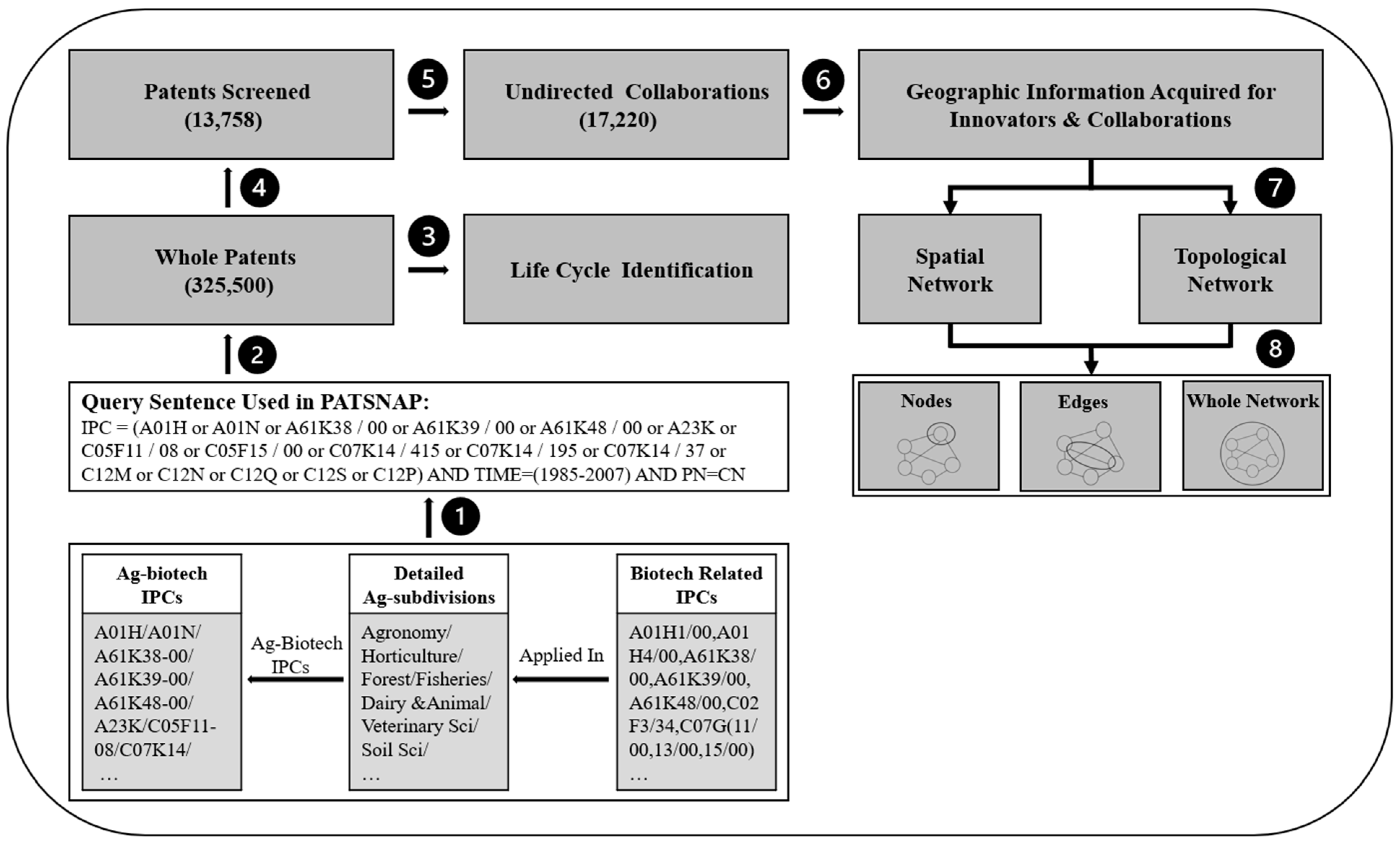
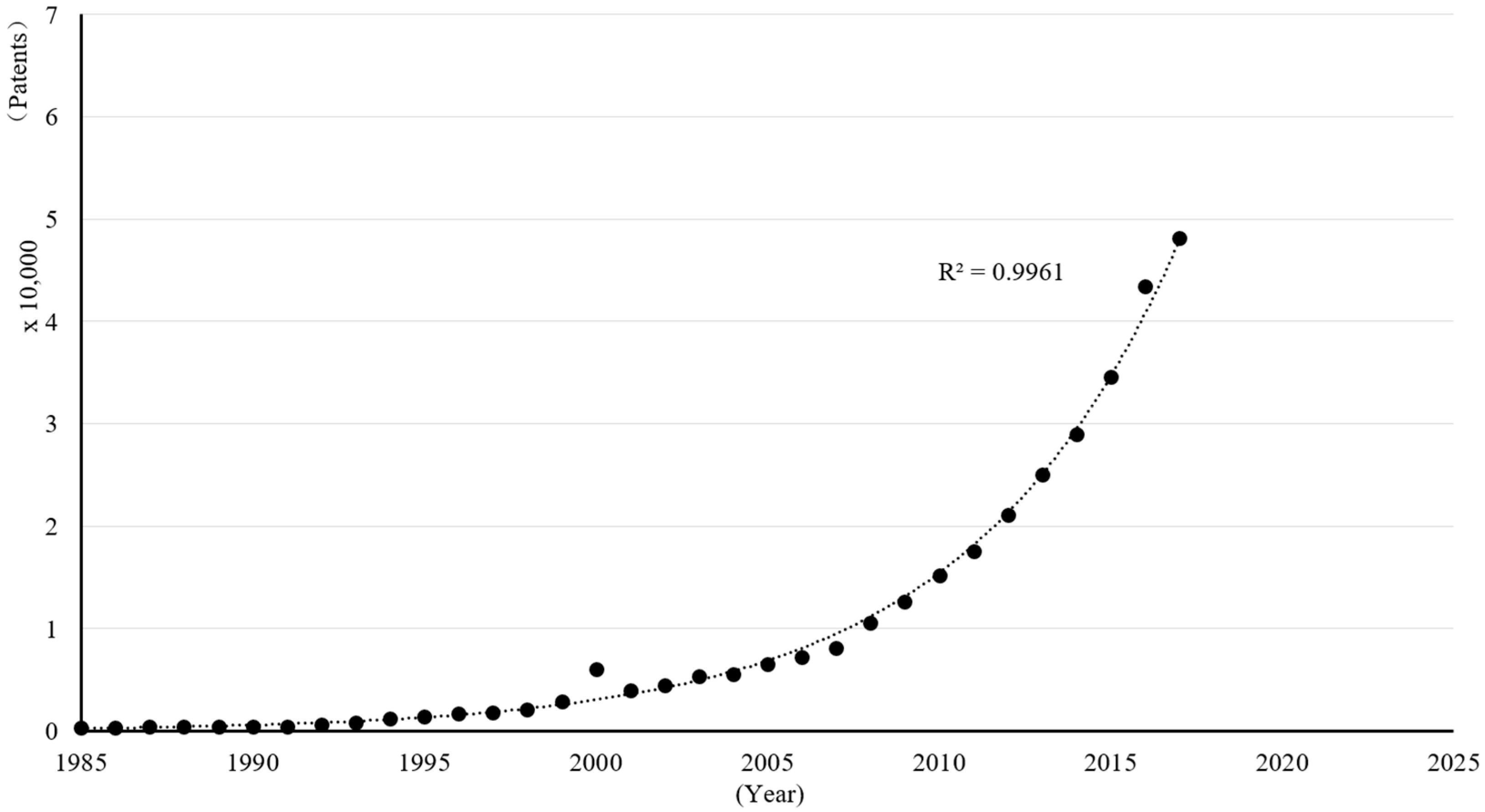


| 1985–2007 | 2008–2015 | 2016–2017 |
|---|---|---|
| City/DC/Ab-DC | City/DC/Ab-DC | City/DC/Ab-DC |
| Beijing/348/0.04 # | Beijing/1712/0.032 # | Beijing/815/0.045 # |
| Shanghai/225/0.026 * | Shanghai/706/0.013 * | Guangzhou/483/0.027 § |
| Shenzhen/90/0.01 § | Shenzhen/619/0.012 § | Shanghai/471/0.026 * |
| Guangzhou/88/0.01 § | Guangzhou/540/0.01 § | Shenzhen/309/0.017 § |
| Suzhou/74/0.009 * | Suzhou/397/0.007 * | Nanjing/228/0.013 * |
| Hangzhou/73/0.008 * | Hangzhou/374/0.007 * | Hangzhou/218/0.012 * |
| Chongqing/68/0.008 | Nanjing/366/0.007 * | Tianjin/213/0.012 # |
| Nanjing/64/0.007 * | Tianjin/351/0.007 # | Suzhou/195/0.011 * |
| Qinzhou/56/0.006 | Qinzhou/331/0.006 | Wuhan/146/0.008 |
| Wuhan/48/0.006 | Shenyang/285/0.005 | Chengdu/136/0.008 |
| 1985–2007 | 2008–2015 | 2016–2017 |
|---|---|---|
| Collaboration/Strength | Collaboration/Strength | Collaboration/Strength |
| Beijing #–Shanghai */57 | Beijing #–Hangzhou */120 | Guangzhou §–Shenzhen §/76 |
| Shanghai *–Suzhou */40 | Beijing #-Shenzhen §/108 | Beijing #–Shanghai */53 |
| Beijing #–Qinzhou/28 | Beijing #–Chongqing/104 | Beijing #–Hangzhou */53 |
| Qinzhou–Fushun/26 | Beijing #–Qinzhou/91 | Beijing #–Tianjin #/44 |
| Shanghai *–Hangzhou */24 | Beijing #–Tianjin #/82 | Beijing #–Shenzhen §/42 |
| Beijing #–Lianyungang/23 | Shenzhen §–Yangzhou */71 | Shanghai *–Suzhou */42 |
| Shanghai *–Chongqing/20 | Beijing #–Shanghai */69 | Shanghai *–Ningbo */40 |
| Beijing #–Chongqing/19 | Zhongshan §–Guangzhou §/67 | Beijing #–Nanjing */36 |
| Shenzhen §–Dongguan §/19 | Beijing #–Changsha/58 | Beijing #–Chongqing/36 |
| Beijing #–Tianjin #/18 | Beijing #–Lianyungang/52 | Shanghai *–Shenzhen §/36 |
Disclaimer/Publisher’s Note: The statements, opinions and data contained in all publications are solely those of the individual author(s) and contributor(s) and not of MDPI and/or the editor(s). MDPI and/or the editor(s) disclaim responsibility for any injury to people or property resulting from any ideas, methods, instructions or products referred to in the content. |
© 2023 by the author. Licensee MDPI, Basel, Switzerland. This article is an open access article distributed under the terms and conditions of the Creative Commons Attribution (CC BY) license (https://creativecommons.org/licenses/by/4.0/).
Share and Cite
Ma, H. The Dynamics of China’s Collaborative Innovation Network in Agricultural Biotechnology: A Spatial-Topological Perspective. Systems 2023, 11, 73. https://doi.org/10.3390/systems11020073
Ma H. The Dynamics of China’s Collaborative Innovation Network in Agricultural Biotechnology: A Spatial-Topological Perspective. Systems. 2023; 11(2):73. https://doi.org/10.3390/systems11020073
Chicago/Turabian StyleMa, Hongkun. 2023. "The Dynamics of China’s Collaborative Innovation Network in Agricultural Biotechnology: A Spatial-Topological Perspective" Systems 11, no. 2: 73. https://doi.org/10.3390/systems11020073





